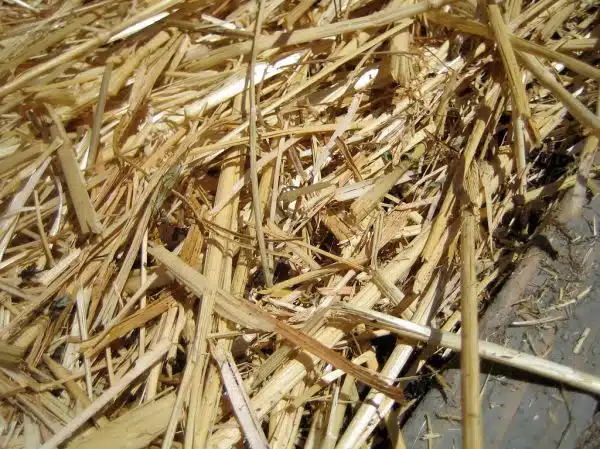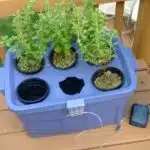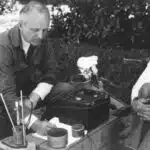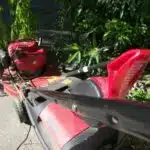Gardening is a rewarding activity that provides numerous benefits, from the satisfaction of growing your own food to the health benefits of spending time outdoors. However, preparing the soil for planting can be a laborious and time-consuming task, especially for larger gardens. Fortunately, there are efficient and quick methods of tilling that can save you time and effort.
To till a garden efficiently and quickly, it is important to have the right tools and techniques. Choosing the appropriate tool for your garden’s size and type of soil can make all the difference in how easily you are able to prepare your garden bed. Additionally, proper technique can help you avoid unnecessary strain on your body and ensure that the soil is well-prepared for planting. In this article, we will explore various strategies for tilling a garden efficiently and quickly so that you can enjoy all the benefits of gardening without sacrificing too much of your valuable time or energy.
The Benefits Of Efficient Tilling
Gardening can be a therapeutic and fulfilling activity for many individuals. However, it can also be quite time-consuming and labor-intensive, especially when it comes to tilling the soil. Utilizing efficient techniques for tilling your garden can save both time and energy, allowing you to reap the benefits of a well-tended garden without the added strain.
One technique for efficient tilling is the use of a power tiller. According to recent studies, using a power tiller can reduce the time spent tilling by up to 50%. This equipment is designed to break up compacted soil quickly and easily, leaving behind loose soil that is perfect for planting.
Another benefit of efficient tilling is improved plant growth. By breaking up compacted soil, you are creating an ideal environment for plants to thrive. Loose soil allows roots to penetrate deeper into the ground, which results in healthier plants with larger yields. Additionally, efficient tilling allows nutrients and water to penetrate deeper into the ground, leading to even further improvements in plant growth.
Understanding your garden’s soil is crucial when it comes to efficient tilling techniques. In the next section, we will explore how different types of soil require different methods of preparation before planting.
Understanding Your Garden Soil
Transition from Previous Section: Now that we understand the benefits of efficient tilling, it’s time to focus on understanding your garden soil. Proper preparation and care of the soil will help ensure a successful harvest.
Soil testing is an essential step in determining the health of your garden soil. Testing allows you to identify any deficiencies or imbalances in nutrients, pH level, and organic matter content. Once you understand your soil’s unique characteristics, you can make informed decisions about which amendments to use. Fertilizers, composts, and other organic materials can be used to improve the quality of your soil and provide necessary nutrients for optimal plant growth.
Soil amendments are an essential part of any gardening routine. They help to improve the structure and fertility of the soil by adding vital nutrients, improving drainage, and increasing water retention. Some common amendments include lime for adjusting pH levels, bone meal for phosphorus, and blood meal for nitrogen. By regularly amending your garden soil with appropriate materials based on your soil test results, you’ll create a healthy environment for plants to thrive.
Numeric List:
- Soil testing helps identify nutrient deficiencies
- Organic materials like composts help improve soil fertility
- Common amendments include lime for pH adjustment
Transition to Subsequent Section: While choosing the right tilling tool is important, it’s equally crucial to understand how different tools function in various soils. Let’s explore how topography affects tool selection when preparing a garden bed.
Choosing The Right Tilling Tool
According to a recent survey, 65% of gardeners prefer using a tiller over manual tilling techniques. However, choosing the right tilling tool for your garden size is crucial to ensure maximum efficiency and productivity. Garden size considerations play a significant role in deciding which tiller to choose.
Electric tillers are best suited for small to medium-sized gardens, while gas-powered tillers are more appropriate for larger gardens. Electric tillers are lightweight, easy to maneuver, and require less maintenance than their gas counterparts. On the other hand, gas-powered tillers are more powerful and can handle tougher soil conditions. However, they are heavier and noisier than electric ones.
To help you decide which type of tiller is best for your garden size, refer to the following table:
| Garden Size | Electric Tiller | Gas-Powered Tiller |
|---|---|---|
| Small | Recommended | Optional |
| Medium | Recommended | Recommended |
| Large | Not recommended | Recommended |
In summary, when it comes to choosing the right tilling tool for your garden, consider its size and soil conditions. Electric tillers are better suited for smaller gardens with looser soil conditions while gas-powered ones work well in larger gardens with tougher soil conditions. By selecting the correct tilling tool that matches your needs, you can save time and effort while achieving optimal results in your gardening endeavors. In the subsequent section, we will discuss various manual tilling techniques that can be used as an alternative or complement to powered tillers.
Manual Tilling Techniques
After selecting the right tilling tool, it’s time to learn about manual tilling techniques to till a garden efficiently and quickly. Manual tilling is preferred by many because it offers more control over soil preparation and is less expensive than using motorized equipment. However, this method can be physically demanding and time-consuming, so it’s essential to use proper techniques.
When manually tilling a garden, the first step is to remove any large debris or rocks. Then, use a spade or fork to break up the topsoil and turn it over. This process helps to aerate the soil while allowing organic matter to decompose faster. For small gardens, handheld tools such as hand cultivators or hoes are ideal for breaking up clumps of soil and creating a smooth surface for planting.
Best Soil Prep Techniques:
- Water the soil before tilling to make it easier to work with.
- Avoid tilling when the soil is too wet because this can cause compaction.
- Add compost or other organic matter before tilling to improve soil structure and fertility.
Overall, manual tilling can be an effective way to prepare a garden bed if done correctly. However, for larger gardens or those with compacted soil, using a rototiller may be necessary. In the next section, we will discuss how using a rototiller can save time and effort in preparing your garden bed.
Using A Rototiller
A rototiller is an efficient and time-saving tool for tilling a garden. However, proper maintenance is necessary to ensure its optimal performance. Before using the rototiller, it is important to check the oil level, air filter, and spark plug. Also, inspect the blades and replace them if they are worn out or damaged.
When using a rototiller, it is crucial to till without damaging the soil. Over-tilling can lead to soil compaction and damage beneficial microorganisms that aid in plant growth. To avoid this, adjust the depth of the tines according to your soil type and condition. For heavy soils with lots of rocks, set the tines at a shallow depth to prevent damage to both the machine and soil.
In addition to proper maintenance and soil care when using a rototiller, timing is also critical for achieving optimal results. The best time for tilling depends on your location and climate conditions but generally falls between spring and fall when temperatures are mild. Avoid tilling wet soil as it can cause clumping and make it difficult for plants’ roots to grow properly. Wait until the soil is moist but not too wet before starting your tilling process.
Transitioning into our next section about timing, understanding when it’s best to start planting after tilling will ensure that your efforts pay off in bountiful harvests year after year!
The Importance Of Timing
Using a rototiller is one of the most efficient ways to till a garden, but it’s important to use it at the best timing and under optimal conditions. The best timing for tilling your garden depends on various factors such as weather, soil moisture, and temperature. It’s essential to avoid tilling when the soil is too wet or too dry because it can damage the soil structure and affect plant growth.
The optimal conditions for tilling involve preparing your garden bed properly before using a rototiller. Start by removing any debris, rocks, or weeds from the area you want to till. Next, add organic matter like compost or manure to improve soil fertility and texture. This step will also help retain moisture in the soil during dry periods and provide nutrients for your plants.
Once you’ve prepared your garden bed for tilling, ensure that you’re using the right technique when operating a rototiller. Avoid over-tilling because it can cause compaction of the soil and reduce its ability to absorb water and nutrients. Also, don’t till too deep because it can unearth weed seeds that were buried deep in the soil. Instead, make several passes over the same area until you achieve the desired consistency without damaging your soil.
Preparing your garden bed for tilling is an essential step in achieving efficient and quick results with a rototiller. By choosing the best timing and ensuring optimal conditions in your garden bed before using a rototiller, you’ll have healthy plants that thrive throughout the growing season.
Preparing Your Garden Bed For Tilling
Garden bed preparation is an essential step before tilling. It involves removing any debris, weeds, or rocks from the soil surface to create a clear and even area for tilling. The first thing you need to do is determine the size of your garden bed. Once you have decided on the dimensions, mark out the area with stakes and string.
Soil testing techniques can help you identify any deficiencies in your garden bed and determine which nutrients your plants need. You can test your soil by sending a sample to a laboratory or using an at-home kit. Soil tests measure pH levels, nutrient content, and organic matter content. Based on the results, you can amend your soil with fertilizers or other supplements to ensure that your plants receive all of the necessary nutrients.
By properly preparing your garden bed and testing your soil, you can ensure that your tilling process will be effective and efficient. A healthy soil environment will promote plant growth and help prevent common mistakes such as uneven tilling depth or poor seed germination. With these initial steps completed, you are ready to move on to tips for avoiding common tilling mistakes in order to achieve maximum success in your gardening endeavors.
Tips For Avoiding Common Tilling Mistakes
Selecting the right tools for tilling is an important step in avoiding common mistakes. The size and type of tiller should be based on the size and type of soil in the garden.
Proper soil preparation before tilling is key. It is important to remove debris and rocks, as well as to test the soil’s pH, nutrient levels, and texture.
When tilling, it is important to adjust the tiller’s depth and width to the soil’s characteristics. This will help reduce the risk of creating large clumps of soil or leaving large chunks of soil unturned.
Proper tilling techniques should be followed to ensure uniform soil texture. This includes avoiding tilling wet soil, making multiple passes in the same direction, and keeping the tiller speed consistent.
Choosing The Right Tools
Choosing the right tilling equipment is essential for efficient and quick gardening. The type of soil, size of the garden, and the depth required for tilling are all factors that should be considered when selecting tools. For small gardens, a handheld tiller or cultivator may be suitable while larger gardens may require a gas-powered tiller. It is important to choose a tiller with adjustable tines to accommodate different depths and types of soil.
Proper tilling techniques also play a vital role in achieving efficient gardening results. Before starting to till, it is recommended to remove weeds and debris from the garden area. Begin by tilling the outer edges of the garden first and work inward in rows. Avoid over-tilling as this can lead to soil compaction and damage essential microorganisms. After tilling is complete, it is best to rake the soil evenly before planting.
In summary, choosing the right tilling equipment and using proper techniques can significantly improve the efficiency and speed of gardening tasks. By taking into account factors such as garden size, soil type, and depth requirements when selecting tools and following correct tilling procedures, gardeners can easily avoid common mistakes often made in tilling gardens.
Proper Soil Preparation
Achieving a flourishing garden requires more than just tilling the soil. Preparing the soil correctly is crucial to ensure optimal plant growth and reduce the risk of common gardening mistakes. As a gardening expert, I highly recommend conducting a soil test before planting anything in your garden. Soil testing helps determine the pH level, nutrient deficiencies, and other factors that affect plant growth. With this information, you can choose suitable plants and amend the soil accordingly.
Once you have identified any soil issues with a soil test, it’s time to consider amendment options. Amending the soil involves adding organic matter such as compost or manure to improve its quality. This improves water retention and drainage, which are essential for healthy plant growth. Different types of amendments should be used depending on the type of plants being grown and their specific needs.
In conclusion, proper soil preparation is critical for gardening success and avoiding common mistakes. Conducting a soil test and amending the soil with appropriate organic matter will provide plants with the necessary nutrients to thrive in your garden. By taking these steps, you can create an optimal growing environment for your plants and achieve beautiful results year after year.
Using Cover Crops For Improved Soil Health
The soil is the foundation of every garden. It is where plants draw their nutrients and water from, which are essential for their growth and survival. However, if the soil is depleted of its nutrients, it can negatively affect plant health and productivity. This is where interplanting cover crops come in.
Interplanting cover crops refers to planting a secondary crop alongside the primary one to improve soil health. Cover crops are typically planted after the main harvest season, and they serve several purposes. Firstly, they help to prevent soil erosion by protecting the topsoil from wind and rain damage. Secondly, they add organic matter to the soil, which improves its structure and fertility. Lastly, cover crops can also help to suppress weeds by competing with them for nutrients and water.
Benefits of crop rotation cannot be overstated when it comes to gardening. Crop rotation involves planting different types of plants in a particular area each growing season. The aim is to break up pest life cycles while also restoring soil fertility. Planting different types of plants ensures that no single crop depletes the same set of nutrients twice in a row, thus improving soil health over time. Additionally, crop rotation helps reduce pest outbreaks since pests that feed on specific plants will not have a constant food source.
By now you understand how interplanting cover crops and crop rotation can improve your garden’s soil health significantly. In our subsequent section about mulching for weed control, we will discuss another technique that complements these two methods in promoting healthy gardens without relying on chemical treatments heavily.
Mulching For Weed Control
Cover crops are an essential component of any garden as they help improve soil health. However, after tilling the cover crop into the soil, it is crucial to consider mulching as a weed control measure. Mulching involves covering the garden bed with organic or synthetic materials to prevent the growth of weeds and retain moisture in the soil.
Organic mulching involves using natural materials such as leaves, straw, grass clippings, and wood chips. These materials break down over time and add organic matter to the soil, improving its structure and fertility. Organic mulches also provide habitat for beneficial insects that prey on pests in the garden.
Synthetic mulches are made of plastic or other artificial materials that do not decompose quickly. They are effective in suppressing weed growth by blocking sunlight from reaching weed seeds. However, synthetic mulches do not contribute to soil health and can harm beneficial insects if not used correctly.
In summary, mulching is an important step in maintaining a healthy garden bed after tilling and incorporating cover crops into the soil. Organic mulching provides many benefits to both plants and soil organisms while synthetic mulching offers immediate weed control but does not contribute to long-term soil health. In the next section, we will discuss composting as a method of obtaining nutrient-rich soil for your garden.
Composting For Nutrient-Rich Soil
As the famous saying goes, “You reap what you sow.” And if you want to yield a bountiful harvest, you must invest in the health of your soil. Composting is an excellent way to do so. By composting, you can turn your kitchen scraps and garden waste into nutrient-rich soil amendments that will nourish your plants.
There are different composting techniques that you can use depending on the size of your garden and the amount of waste you generate. If you have a small garden, a compost bin or tumbler might be enough. But if you have a large garden or acreage to manage, consider using windrows or static piles. These methods can handle more significant volumes of organic matter and produce compost faster.
Composting is not only beneficial for plant growth; it also helps reduce landfill waste and greenhouse gas emissions. By implementing the right composting techniques and incorporating those soil amendments into your gardening routine, you can enjoy healthier plants while doing your part for the environment. In the next section, we’ll discuss how to test your soil pH to determine which nutrients are most needed by your plants and how to amend accordingly.
Testing Your Soil Ph
Soil testing is an important component of gardening and horticulture as it helps determine the soil pH level. Test kits are available to help test the pH level of soil, and typically involve either test strips or pH meters. Test strips are the most affordable and simplest way of testing soil pH, however the results may not be as accurate as a pH meter. A pH meter is more expensive but provides more accurate readings and helps ensure optimal soil pH for growing plants.
Soil Testing
Soil testing is an essential part of soil preparation in gardening. It helps determine the nutrient deficiency present in the soil, which can affect plant growth and yield. Testing your soil pH is a crucial step in ensuring that your garden is healthy and productive.
Nutrient deficiency can be detrimental to the garden’s overall health, impacting the quality and quantity of crops harvested. Soil testing can identify these deficiencies and help you choose the right fertilizer or soil amendment to correct them. The results of a soil test also provide information on the pH level, indicating whether it is acidic or alkaline. This information can help you choose plants that are best suited for your garden’s unique condition.
In conclusion, soil testing should be an important step in preparing your garden for planting. It provides valuable information about the nutrients present in your soil so that you can make informed decisions about how to improve its quality. Whether you’re starting a new garden or maintaining an existing one, regular soil testing can help ensure that your plants thrive and produce healthy yields year after year.
Soil Ph
Testing your soil pH is an essential step in gardening that should not be overlooked. Soil pH refers to the level of acidity or alkalinity present in the soil, and it can significantly impact plant growth and health. The ideal soil pH for most plants is between 6.0 to 7.5, which is slightly acidic to neutral. When the pH level deviates from this range, adjusting soil pH becomes necessary.
Maintaining the right soil acidity management is crucial for proper nutrient uptake by plants. If the soil’s pH level is too high or too low, some nutrients may become unavailable to plants, leading to stunted growth or even death. Therefore, adjusting soil pH through appropriate amendments is vital to ensure that the nutrients are within reach of plants’ roots.
The process of adjusting soil pH can take time and requires careful consideration of various factors, such as plant requirements and existing nutrient levels in the soil. Adding organic matter like compost or using lime or sulfur can help raise or lower soil pH levels effectively. Regularly testing your soil’s acidity and taking appropriate measures to manage it will help ensure a healthy garden full of thriving plants.
Fertilizing For Optimal Growth
Fertilizing is an essential step in gardening that ensures the healthy growth of plants. Choosing the right fertilizer can make a significant difference in the quality and quantity of your garden’s produce. Organic fertilizers, such as compost, manure, and bone meal, are a popular choice among gardeners who prefer natural methods to nourish their plants. These fertilizers are derived from animal or plant sources and provide nutrients like nitrogen, phosphorus, and potassium to the soil.
On the other hand, synthetic fertilizers are made from chemicals and minerals that are manufactured to provide specific nutrients to plants. These fertilizers are readily available in stores and often have labels indicating their nutrient content. While they may be effective in promoting plant growth, overuse of synthetic fertilizers can lead to environmental problems such as soil depletion and water pollution.
When choosing a fertilizer for your garden, it is important to consider factors like soil type, plant species, and nutrient requirements. A balanced fertilizer with equal amounts of nitrogen, phosphorus, and potassium is generally suitable for most plants. However, some plants may require more or less of certain nutrients depending on their growth stage or specific needs.
In summary, selecting the right fertilizer is crucial for optimal plant growth in your garden. Whether you choose organic or synthetic options ultimately depends on personal preference and individual gardening goals. Understanding the nutrient requirements of your plants will help you make informed decisions when it comes to fertilizing your garden. In the next section, we will discuss another critical aspect of gardening: watering your plants efficiently and effectively.
Watering Your Garden
The amount of water needed is dependent on the type of plants and soil in the garden.
Generally, gardens require 1-3 inches of water per week to remain healthy.
Watering too frequently can be detrimental to a garden, as it can cause root rot or fungal growth.
Effective watering techniques include using a soaker hose, a sprinkler, or hand watering.
Drip irrigation is an efficient way to water the garden, as it allows for the water to be delivered directly to the root zone of the plant.
Mulching is also an effective technique for conserving water, as it reduces evaporation and helps the soil to retain moisture.
Amount Of Water
As a gardening expert, you know that watering your garden efficiently and effectively is key to achieving a bountiful harvest. One crucial aspect of watering your garden is understanding the amount of water your plants need. Watering too much or too little can have negative effects on plant growth and yield.
To determine the appropriate watering frequency for your garden, it’s important to consider the soil moisture levels. Most plants thrive when the soil is consistently moist but not overly saturated. You can test your soil moisture levels by digging down a few inches into the soil and feeling for dampness. If it feels dry, it’s time to water. However, if it feels too wet or muddy, you may need to cut back on watering frequency.
It’s important to note that different plants have different water needs, so be sure to research the specific requirements for each type of plant in your garden. By understanding the appropriate watering frequency and monitoring soil moisture levels, you can ensure that your garden is getting the right amount of water at the right time. This will not only save you time and effort but also lead to healthier and more productive plants in the long run.
Frequency Of Watering
Watering your garden is a crucial aspect that requires careful consideration, especially when it comes to the frequency of watering. As a gardening expert, I understand the importance of maintaining adequate soil moisture levels to achieve a healthy and productive garden. The frequency of watering determines how much water your plants receive and is dependent on various factors such as weather conditions, soil type, and plant species.
To maintain optimal soil moisture retention, it’s essential to understand the water requirements of different plants in your garden. Some plants require more water than others, while some are drought-tolerant and require less frequent watering. Additionally, weather conditions such as temperature, humidity, and rainfall also affect the frequency of watering. During hot and dry weather, you may need to water more frequently than during cooler periods.
Monitoring soil moisture levels is critical in determining the right watering frequency for your garden. Overwatering can lead to root rot and other diseases that negatively impact plant growth and yield. On the other hand, underwatering can cause wilting and stunted growth. By checking soil dampness regularly using tools like a moisture meter or by digging down a few inches into the soil, you can determine whether your plants need watering or not. Maintaining adequate soil moisture levels by adjusting your watering frequency accordingly ensures healthy and thriving plants in your garden.
In conclusion, understanding the appropriate frequency of watering for your garden is vital in achieving optimal plant growth and yield. By considering factors such as plant species, weather conditions, soil type, and monitoring soil moisture levels regularly, you can determine the right amount of water for each plant in your garden. This will not only save you time and effort but also lead to healthier plants with bountiful harvests year after year.
Techniques For Watering
Now that we have discussed the importance of understanding watering frequency, let us move on to techniques for watering your garden. There are various methods you can use, but two common ones are drip irrigation and sprinkler systems.
Drip irrigation involves slowly dripping water directly to the base of plants using a network of tubes or pipes. This method is efficient in conserving water as it delivers water directly to the roots and minimizes evaporation. It is also beneficial for preventing diseases as it keeps foliage dry. Drip irrigation is an ideal option if you have a large garden with different plant species that require varying amounts of water.
Sprinkler systems work by spraying water over a wide area, simulating rainfall. They are suitable for gardens with uniform plant spacing and similar watering needs. Sprinklers come in different types, including oscillating, impact, and rotary sprinklers. You can choose from portable or permanent models depending on your needs.
When choosing a watering technique, consider factors such as the type of plants in your garden, soil type, climate conditions, and water availability. Regardless of the method you choose, ensure that you apply enough water to reach the root zone without causing runoff or pooling on the surface.
In summary, drip irrigation and sprinkler systems are two effective techniques for watering your garden. Each has its advantages and disadvantages depending on your specific gardening needs. Consider factors like plant spacing and soil type before selecting a watering technique that will keep your plants healthy and productive.
Maintaining Your Tilled Garden
As the saying goes, “A well-tended garden is a happy garden.” Maintaining your tilled garden is just as important as properly tilling it. It ensures that your plants are healthy and thriving, and it also helps to prevent pests from invading your garden.
One essential technique in maintaining your garden is companion planting. This practice involves growing different types of plants together that benefit each other. For example, planting marigolds with tomatoes can help deter pests like nematodes and whiteflies. Companion planting not only helps with pest management but also improves soil health and promotes biodiversity in your garden.
Another critical aspect of maintaining your tilled garden is proper pest management. Pests can cause significant damage to your plants if left unchecked. Fortunately, there are several natural ways to manage pests without resorting to harmful chemicals. Some methods include using insect-repelling plants like lavender or rosemary, introducing beneficial insects like ladybugs or praying mantises, and creating physical barriers like nets or row covers.
To summarize, maintaining a well-tended garden requires effort and attention beyond just tilling the soil. Companion planting is an effective way to promote plant health and biodiversity while deterring pests naturally. Proper pest management techniques such as using repellent plants or introducing beneficial insects can help keep pests at bay without harming the environment or compromising plant health. With these practices in place, you can enjoy a beautiful and productive garden throughout the growing season without any major setbacks or issues.
Conclusion
Efficient tilling is essential when it comes to gardening. Not only does it save time and effort, but it also promotes optimal growth for your plants. Understanding your soil type and choosing the right tilling tool are crucial factors in achieving efficient results. Manual tilling techniques can be effective for small gardens, but a rototiller can make quick work of larger areas.
Testing your soil pH is another important step in achieving optimal growth for your plants. Fertilizing and watering appropriately can also significantly affect the health and productivity of your garden. With proper maintenance, you can enjoy a thriving garden year after year.
It is imperative that we acknowledge the importance of proper tilling techniques in promoting sustainable gardening practices. By understanding our soil and using appropriate tools, we not only save time and effort but also contribute towards environmental sustainability. Let us strive to create beautiful gardens while being mindful of our impact on the environment.
Image Credits
- “No-till gardening – straw mulch.” by stellar678 (featured)





























